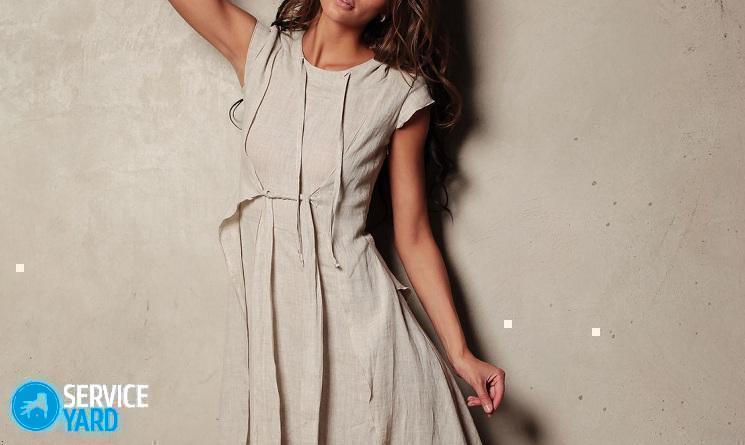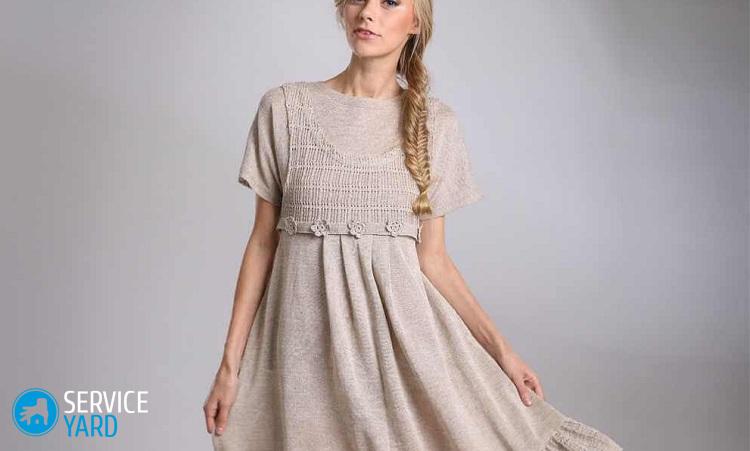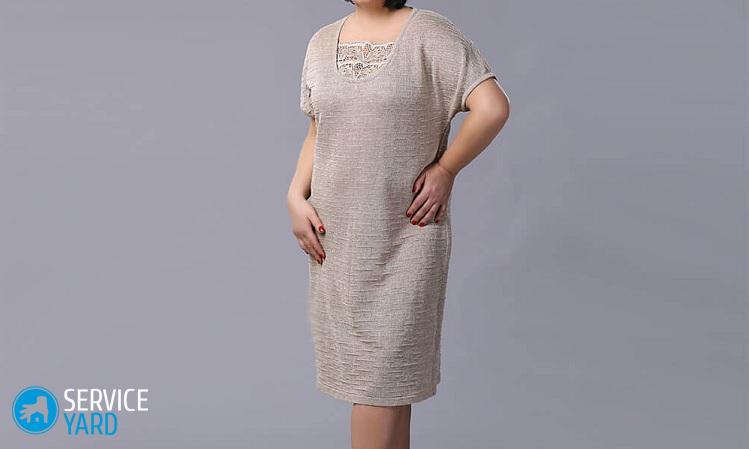Dress linen 🥝 models, styles

Clothes from linen were sewn back in those days when people had no idea either about sewing machines, or about complex patterns. In the century before last, every girl could make a sarafan or shirt from this material, because linen items made up a significant part of her dowry. And this means that it is easy to sew a dress from linen with your own hands, a modern craftswoman will also design it, because she has a lot of things that can greatly facilitate this work. The intricacies of making linen clothes will be discussed in our article.
to contents ↑Why flax?
If we talk about the history of European costume, the craftswomen almost always chose linen simply because he grew up in these parts. They learned to process it many centuries ago, and each nation had its own ways. The styles of European folk clothes differed significantly from one another - some had long sundresses sewn from narrow canvases, while others had short skirts made of wide pieces. It all depended on the design of the loom used in a particular area.
to contents ↑Fabric benefits
Despite the fact that now in sewing stores is full of a variety of different fabrics, linen has not lost popularity. Why? For a number of reasons:
- he practically does not cause allergies in anyone;
- it is easy enough to work with if you know how to cut it correctly;
- You can iron at any temperature;
- on a hot summer day in such a dress will be very comfortable;
- the assortment of fabrics is such that you can sew home, business, leisure, and even evening clothes.
Some features
Thinking about sewing a linen dress with your own hands, consider some of the subtleties of working with this material:
- Linen products wrinkle strongly.
- This material sits during washing.
- If flax is cut incorrectly, the edges will shag almost immediately.
- The fabric is not very draped.
Choose a style
Based on the characteristics of the material, it becomes completely obvious that creating a dress from linen with your own hands is best done in a straight cut or slightly fitted. And it is no less obvious that for many models you will need a pattern, since linen is not particularly draped, so it is unlikely to form a silhouette due to folds and assemblies.
But there are styles for which patterns are not needed. The best options:
- traditional sundress;
- shirt dress with or without a belt;
- detachable dress with a straight or slightly flared skirt.
- classic straight dress with one-piece skirt.
If the question arose, how to sew a dress from linen for those who do it yourself, you will find the answer to it in any collection. Take a closer look, and you will see that almost all the styles of linen dresses are suitable for both thin and short ones.
to contents ↑Dress shirt
You can sew a dress from linen without a pattern as in the photo. More precisely, cutting is done directly on the fabric. Since modern linen cuts come in a wide variety of widths, choosing the one with a 150 cm spacing between the edges is easy. But first you need to take some measurements:
- girths of the neck, chest and hips;
- if the dress will be with a belt, you need a waist circumference;
- product length - from the cervical vertebra to the hem;
- sleeve length - from the shoulder to the edge (the sleeve can be short, to the elbow, three quarters or long - it is measured along the bent arm).
We divide the horizontal measurements in half, as is usually done. As for calculating the fabric for a shirt dress, it is done like this:
- Fold the hips half and double the length of the sleeve.
- Compare the resulting measurement with the cut width.
- If the amount is less than the cut width, you will need 2 product lengths, if more - 3.
Important! It must be taken into account that flax sits very strongly after the first wash, that is, another thirty percent must be added to the calculated amount.
Getting ready for sewing
Before you start cutting, you need to decorate the material. This procedure is required in any case, regardless of which style you choose:
- Soak the cloth in warm water and hold it there a little.
- Squeeze gently and allow to dry a little to keep it moist.
- Iron with a hot iron by setting the control to the “flax” mark and dry.
Fabrics less prone to shrinkage (for example, some types of cotton) can not be washed, but ironed through wet gauze. But with flax such a number will not work.
Important! It should be ironed on the wrong side and do not leave the iron standing - it can leave tan marks.
Cut
The sweep of the dress is a cross. It is done like this:
- Fold the fabric across.
- Find the middle of the fold.
- Draw a line parallel to the edges to the bottom.
- Put the length of the product on it.
- Through this point, draw perpendiculars to the edges on both sides.
- On the edges from the fold, set aside half the width of the sleeve.
- Draw perpendiculars to join with the middle line.
- From the midline on both sides of this line, set aside the half-circumference of the hips divided by 2.
- From these points, draw perpendiculars towards the bottom line.
- Add 1 cm allowance over all sections, and 3 cm along the bottom line.
- For the neckline from the point at which you started the construction, set aside the neck half-neck in two directions.
- Set aside a section of 10-15 cm for the fastener down from the same point.
- Cut the neck and make a cut in front.
Important! For cutting such a dress, a tailor's square - wood or metal - will turn out to be a very useful thing.
Start sewing
You have a chance to sew a summer dress from linen with your own hands much faster than the girls did two hundred years ago. After all, you have a sewing machine, and in addition, you can buy some details for decoration in the store - for example, Vologda lace from unpainted linen. It will look especially stylish on a bright dress.
Of course, you should start from the side seams, which continue on the sleeves. Sew them in continuous stitching. Iron allowances on the sides and process them - best with an overlock, but if it is not there, this can also be done manually with a buttonhole stitch.
Important! It is for such models, made in the folk style, you can apply a seam, it is also linen.
Sleeves
The processing of the sleeves can also be traditional - for example, they can simply be hemmed by folding it on the wrong side twice - by 0.5 cm and 1 cm. You can also make them with elastic. But the product will look much more interesting if it is sheathed with wide Vologda lace:
- Fold the allowance 0.5 cm to the wrong side.
- Sew a strip of lace to the seamy side, laying it in folds (you can outline it in advance).
- Sew on the front side.
- Overlock the seam allowance.
- Sew the edges of the lace - it is better to make a seam from the bottom side and hide it in a fold.
Neck
To process the neck and cut, cut out several strips 3-5 cm wide:
- 1 for the back;
- 2 - for shelves from shoulder to incision;
- 2 - for the cut.
The simplest processing of the neckline of a shirt dress is as follows:
- Fold the strip designed for the back with the dress facing up.
- Sew it close to the edge.
- Iron on the wrong side.
- Bend the free long stock.
- Stitch it from the side of the shirt at a distance of 0.5 cm from the edge.
- Sew the strips to the cut in the same way, and then to the shelves.
- Cut the touching edges at an angle, leaving small allowances.
- Iron allowances inside out.
- Sew the edges.
Section design options
The section can be left open without any decor. But there are other ways:
- the lace and neckline is the same as on the sleeves;
- braid trim;
- lacing.
For lacing, 4-6 eyelets will be needed - you can insert them in the workshop or with the help of a special machine, which is now quite easy to buy, they are sold in the same place where there are different little things for sewing.
to contents ↑Important! An interesting design option for a shirt dress is embroidered stripes that are sewn along the edges of the sleeves, the neckline, neckline and hem. A woven belt in a folk style is suitable for such a dress.
Linen suit
From this material you can make a summer suit from a one-piece shirt and skirt. Do-it-yourself linen skirt can be flared, as well as with assemblies. How to sew a shirt, you already know. As for the skirt, the easiest option is “Tatyana,” which has recently become popular again. Pattern for her is not required. You need to know:
- waist circumference:
- hip girth;
- product length.
So, in addition to the standard accessories for sewing, you need:
- fabric - 1 or 2 lengths of the product, depending on the number of assemblies, the width of the hips and the cut;
- elastic tape.
Cut
"Tatyanka" lies in the shared:
- Spread the cut on a horizontal surface in one layer.
- Determine where you will have the upper hand - it is best to mark it somehow.
- Check how flat the top line is - it is best to do it on a square.
- Trim the cut.
- Set down the seam allowance along the edges.
- Set aside the length of the product.
- Set aside the hem hem.
- Connect all the points in pairs.
- Cut the workpiece along the bottom line.
Assembly
Such a skirt has only one seam, and it is necessary to start with it. Stitch along the inside edge of the hem. Flatten the oversize - since you did not cut the edge, you don’t need to overcast anything:
- Cut a piece of elastic tape (its length should be slightly less than the waist, so that the elastic was stretched while wearing - but the belt should not be too tight).
- Sew short ends.
- Starting from the back seam, sew the elastic to the skirts - the line goes from the elastic.
- Overcast the stock along with the edge of the elastic.
- Keep in mind that when stitching, the elastic tape should be slightly stretched.
- In principle, the skirt is ready - it remains only to hem the bottom, and this is done in the most usual way.
How to cut flax?
In principle, absolutely any dress can be sewn from linen. But, as a rule, experienced craftsmen prefer to sew styles with straight lines from such material. And it always has been. Why? Because in this case it is possible to cut the flax perfectly evenly so that it crumbles as little as possible.
To cut the transverse strip, we do this:
- Mark the width of the strip at the edge.
- Pry the transverse thread (weft) with a needle and pull it out - you will get a perfectly even transverse strip.
- On this strip, cut the canvas with very sharp scissors or a blade.
The longitudinal strip is cut in exactly the same way, only the warp thread is pulled out. And if you do not need to cut the entire panel - as, for example, when cutting dresses-shirts? Then you should determine the thread that you want to pull out, find the place where it intersects with the mark (for example, a side cut), make a very neat cut there (just cut this thread without touching the neighboring ones) and pull it out.
to contents ↑Stock footage
In a word, in order to sew a dress or skirt from linen, you have to work hard. But then the product turns out to be glorious - lightweight, comfortable and hygienic. And if the flax is cut correctly, it will crumble less, although, of course, this procedure does not eliminate the need to process the seams.
- How to choose a vacuum cleaner taking into account the characteristics of the house and coatings?
- What to look for when choosing a water delivery
- How to quickly create comfort at home - tips for housewives
- How to choose the perfect TV - useful tips
- What to look for when choosing blinds
- What should be running shoes?
- What useful things can you buy in a hardware store
- Iphone 11 pro max review
- Than iPhone is better than Android smartphones






